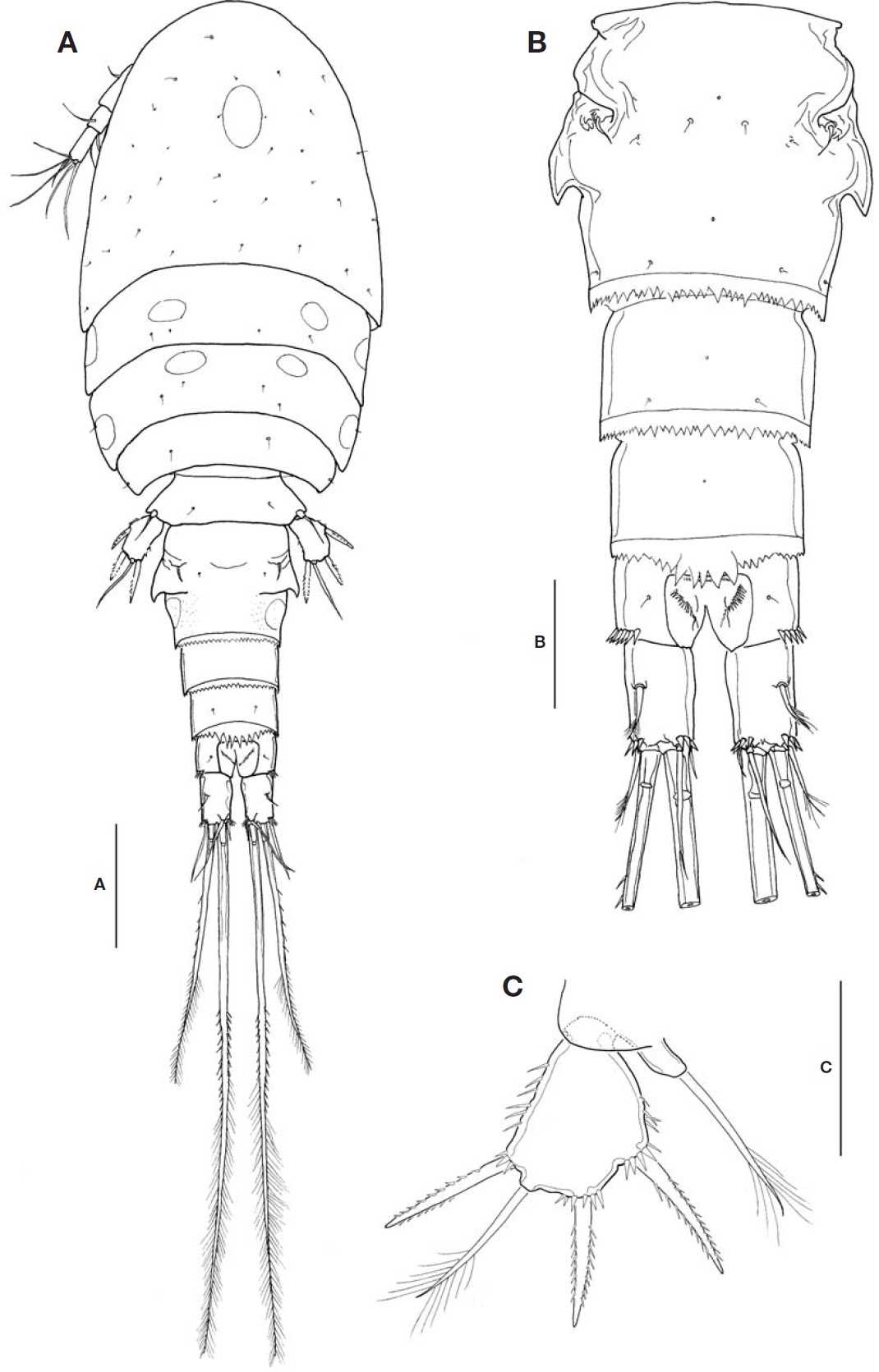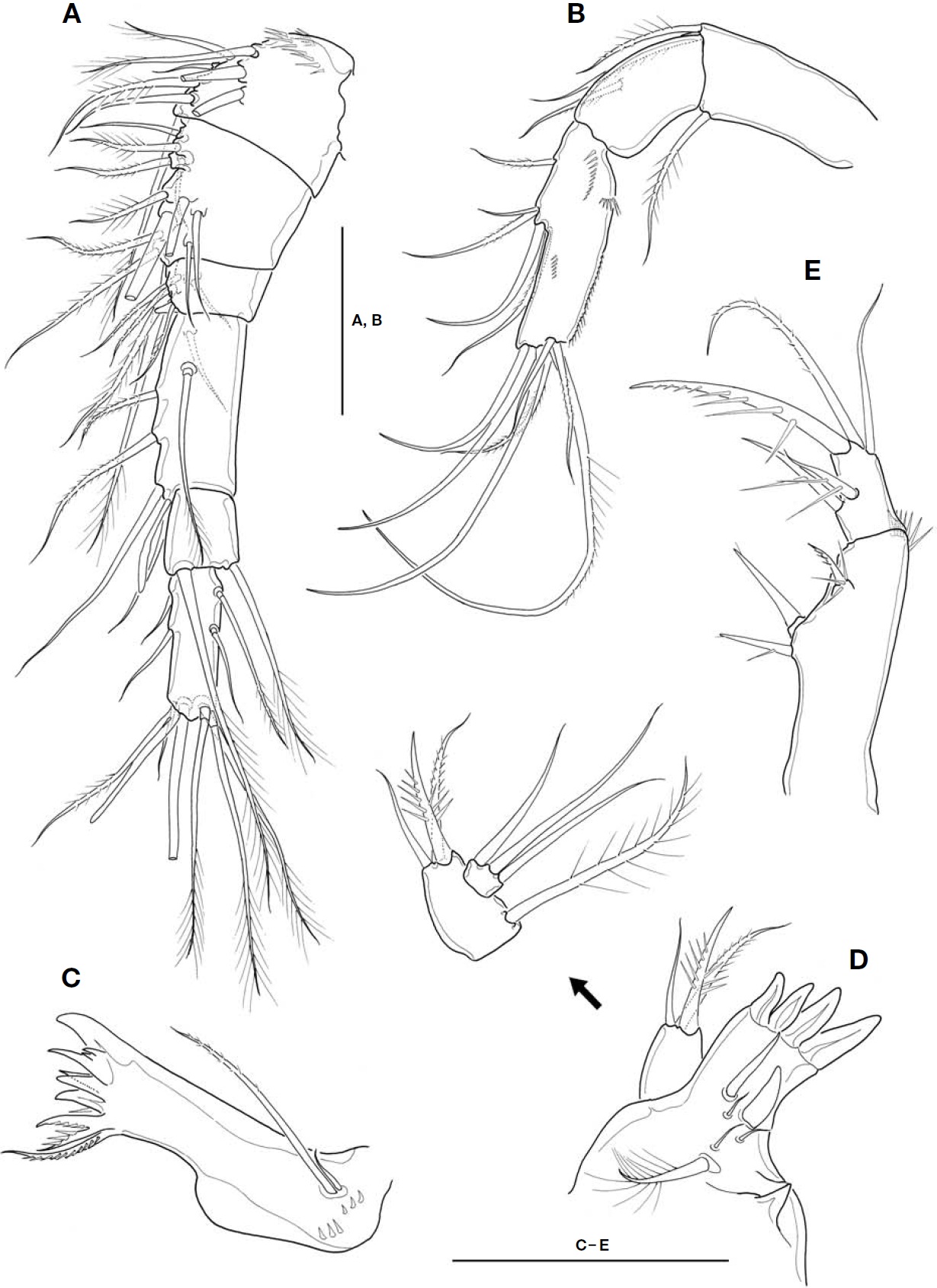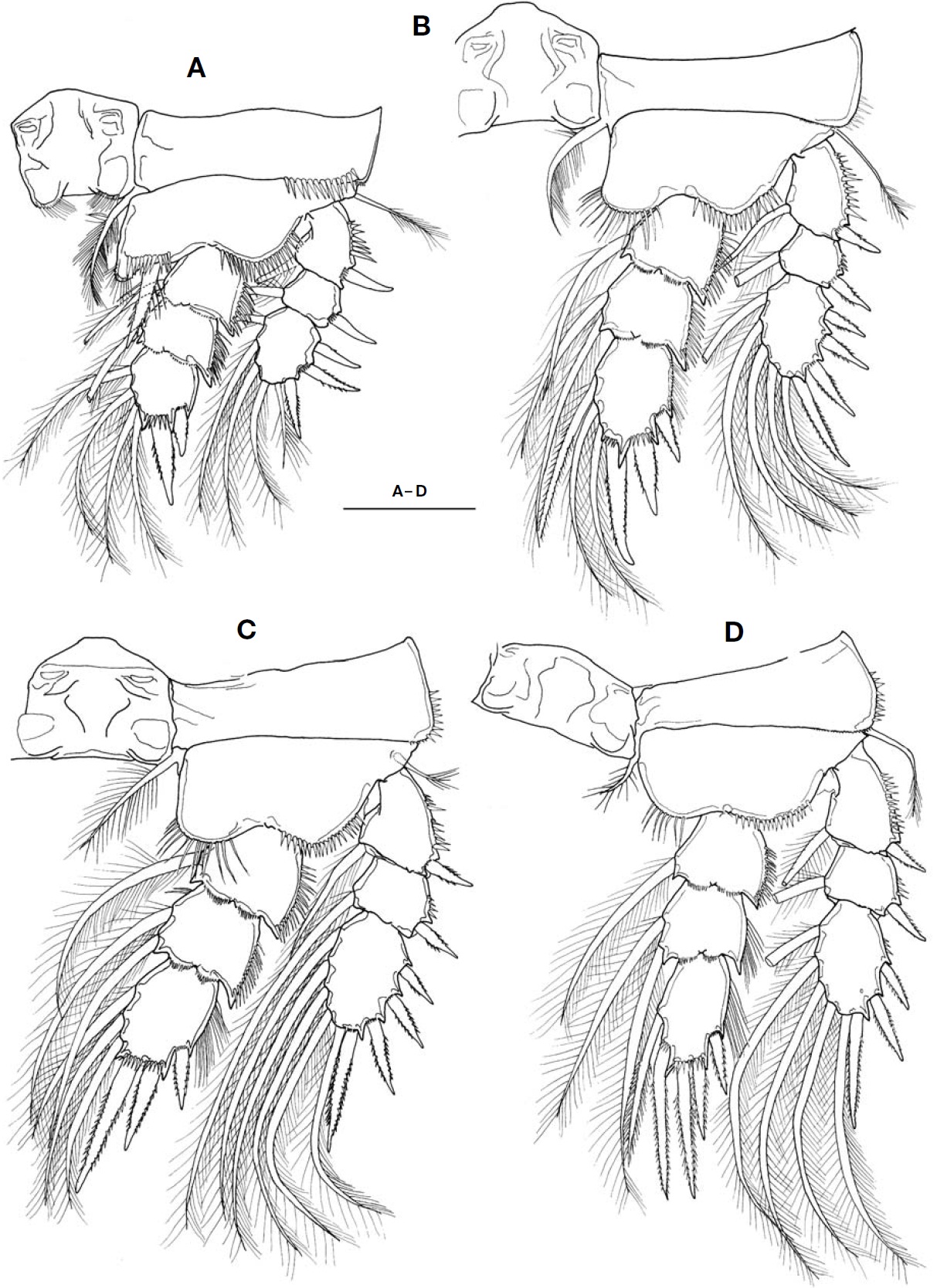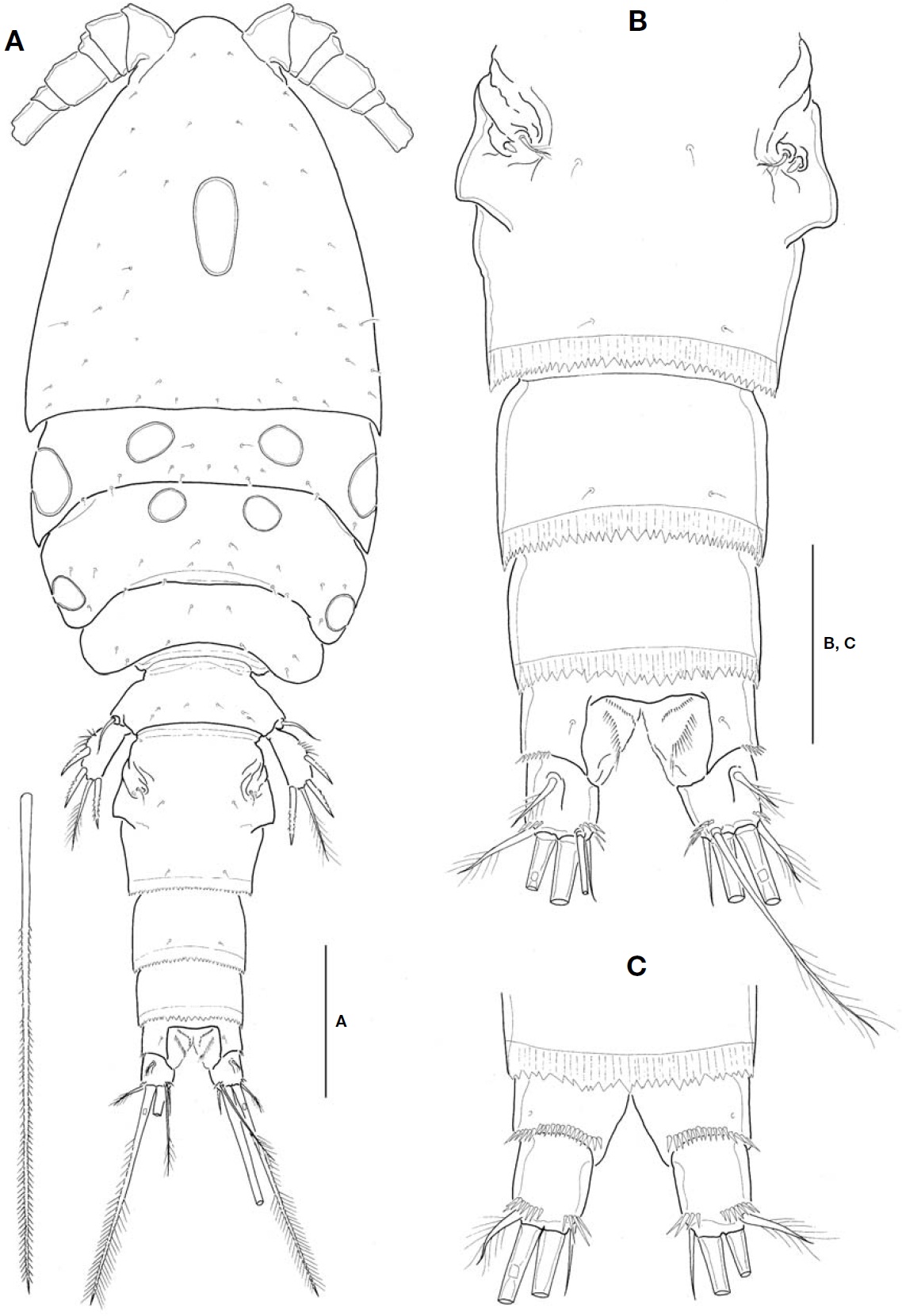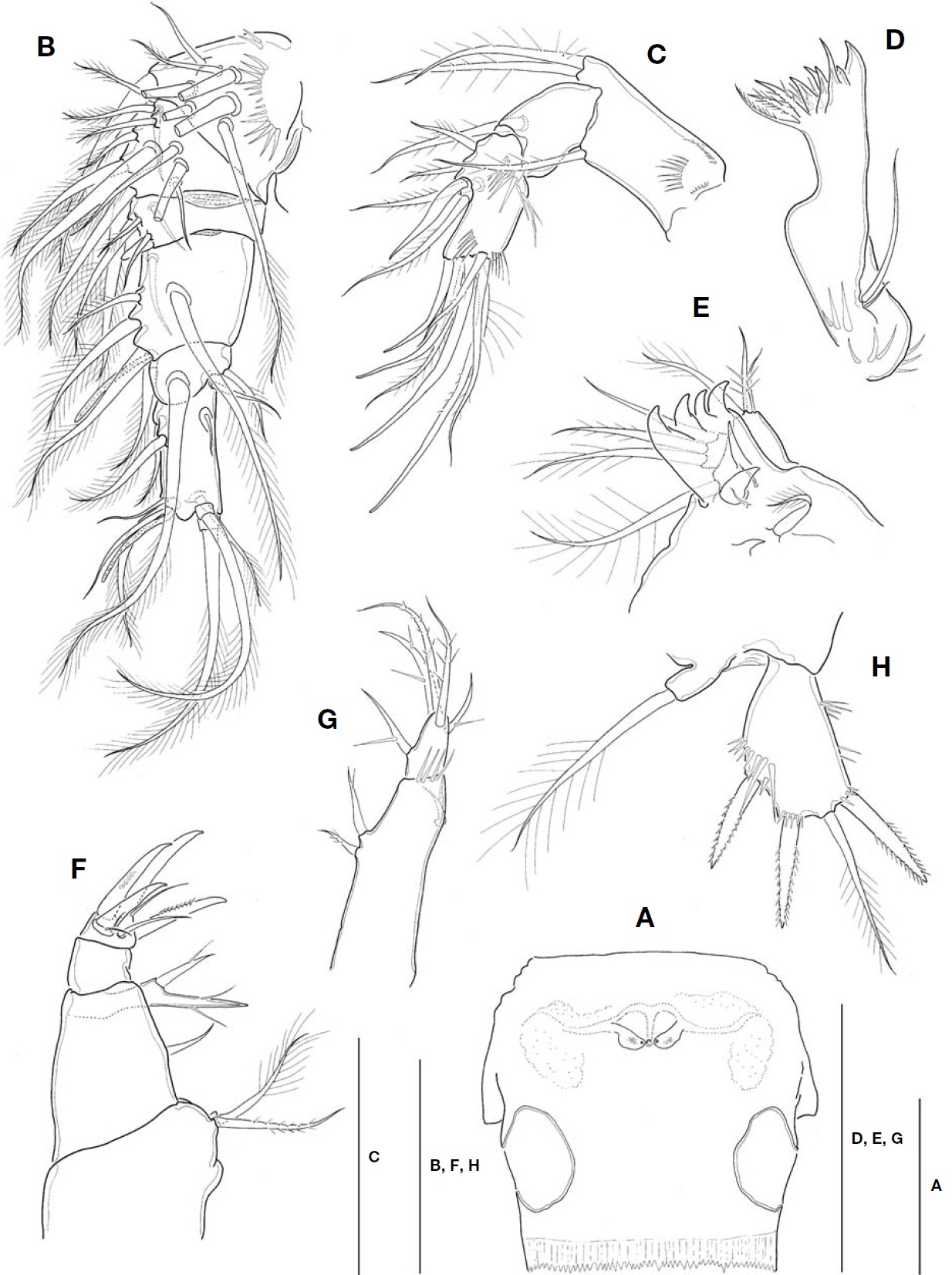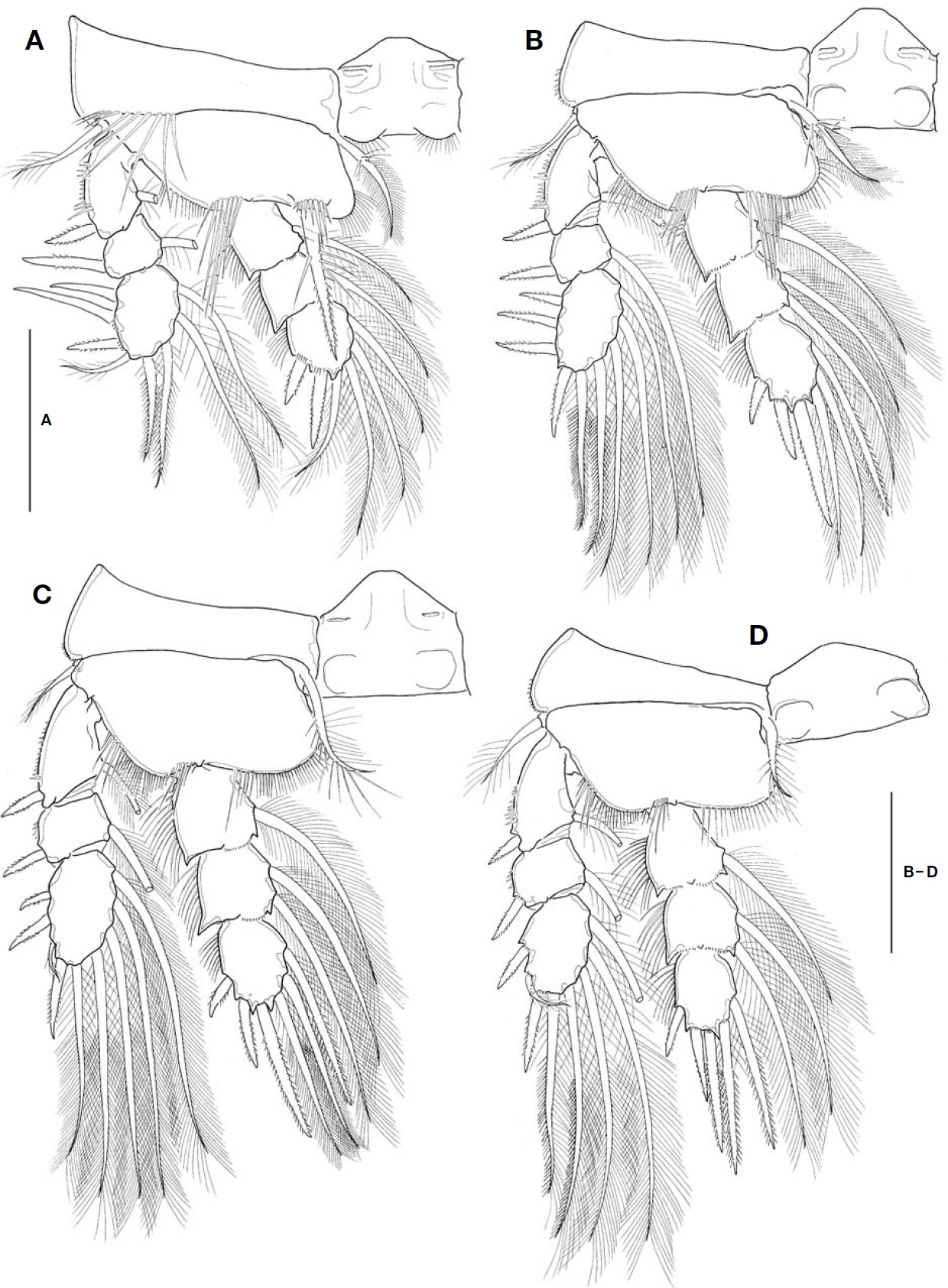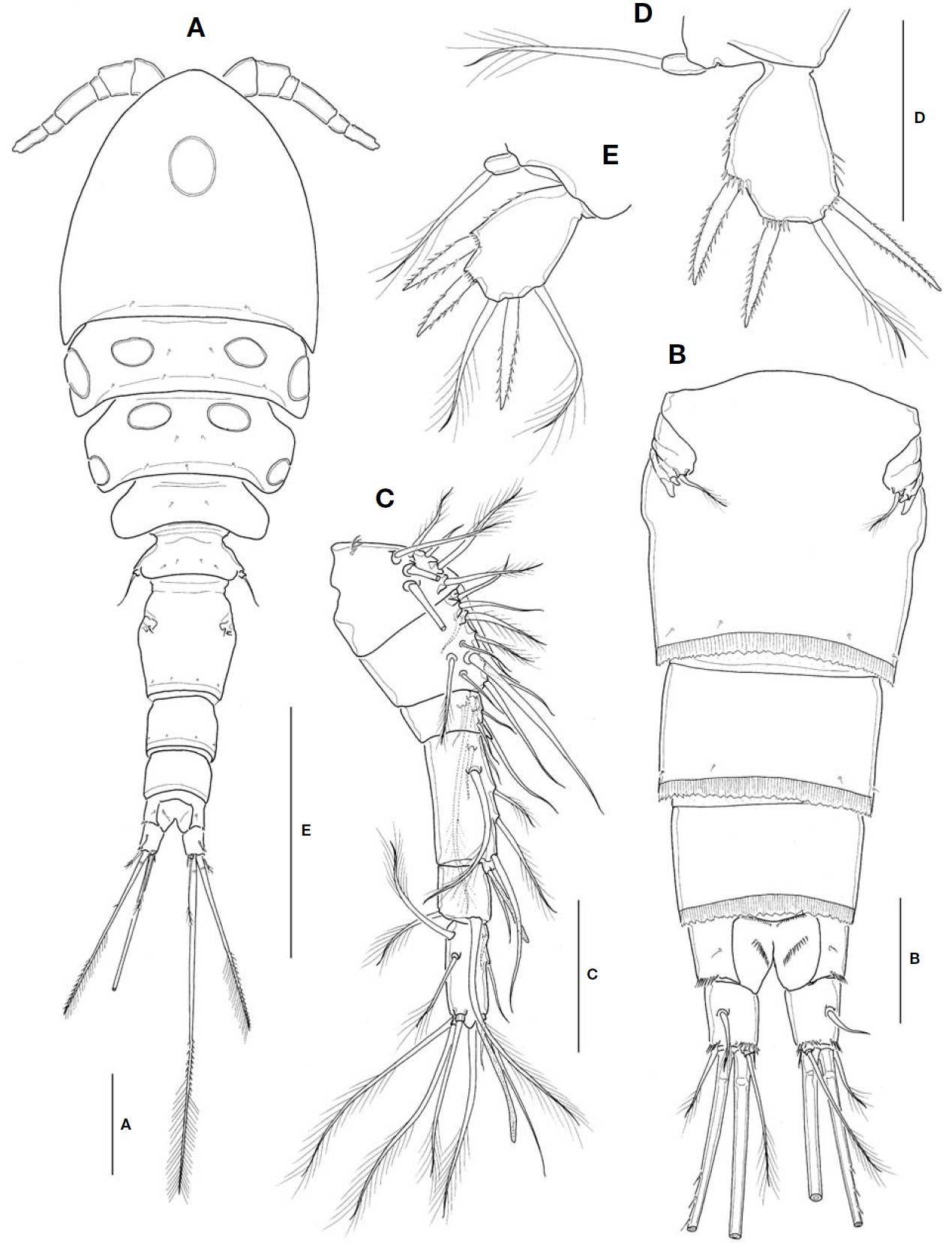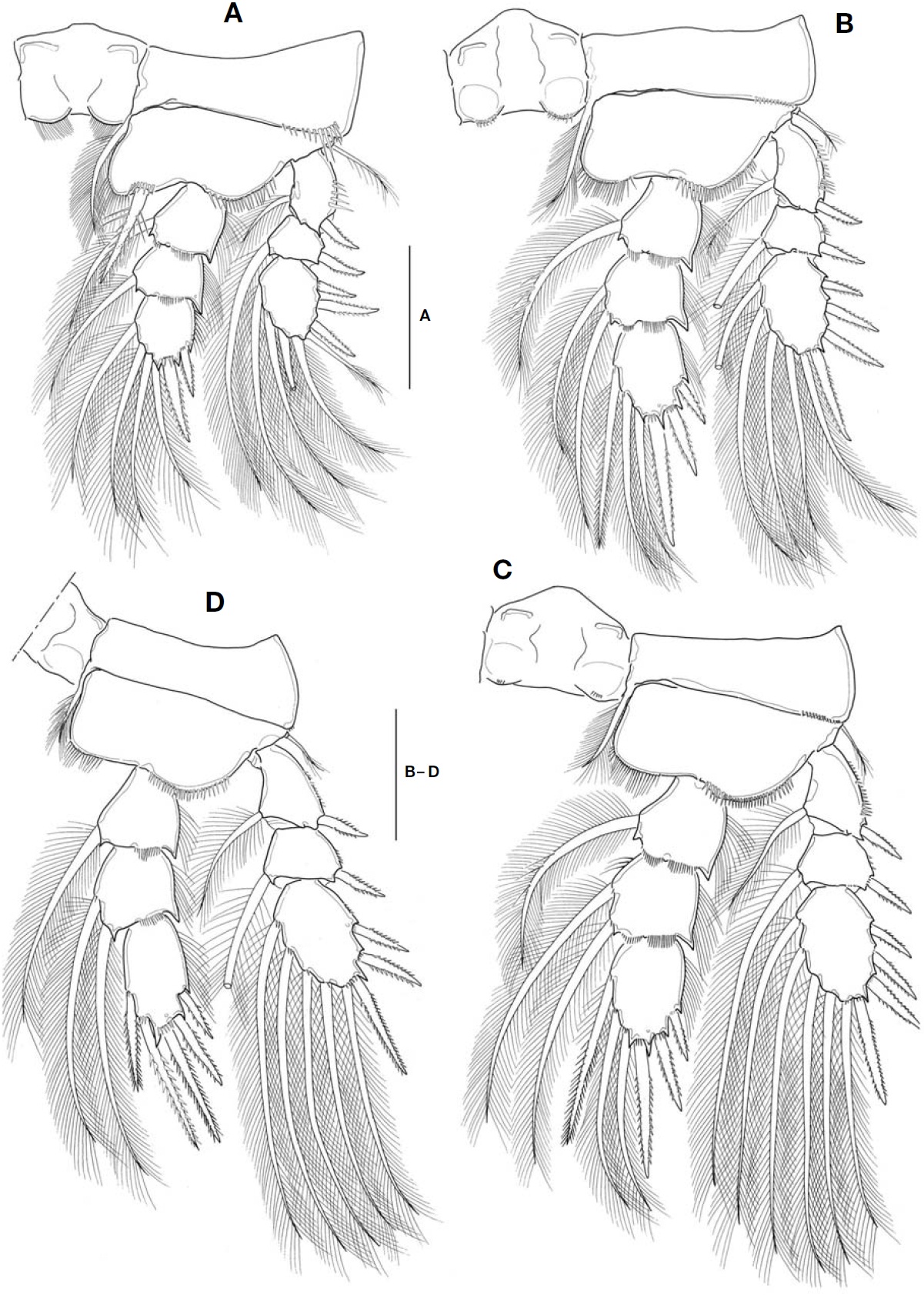



As mentioned in our previous paper (Chang and Lee, 2012),
In Korea, Yoo and Lim (1989) first reported a
The genus
The authors have attempted to make a comprehensive reexamination of the previous records of
Materials examined in the present study consists of the previous records and the specimens obtained from various brackish waters in South Korea since October, 1989, which are stocked in the Department of Biological Science, Daegu University. Samplings were made mostly using a dipnet or a conical plankton net of 64 μm mesh aperture. Copepods were fixed and stored in 4% buffered formalin or in 80% ethanol.
Methods for preparation, observation, measurements are same as in our previous paper (Chang and Lee, 2012).
Voucher specimens have been deposited in the National Institute of Biological Resources, Incheon, Korea, and in the specimen room of the Department of Biological Science, Daegu University, Korea.
Morphological terminology mostly follows Huys and Boxshall (1991). Abbreviations used in the text and figure legends: A1, antennule; A2, antenna; Fu, caudal ramus; L/W, length to width ratio; P1-P5, legs (pereiopods) 1-5; enp1- 3 or exp1-3, the first to third endopodal or exopodal segments of each leg.
Order Cyclopoida Burmeister, 1834
Family Cyclopidae Dana, 1846
Subfamily Halicyclopinae Kiefer, 1927
Genus Halicyclops Norman, 1903
1*Halicyclops uncus Ueda and Nagai, 2009 (Figs. 1-3)
Material examined. Korea: 3♀♀, Pohang, estuary of Gokgangcheon Stream, 3 Feb 2004, Chang CY, Lee J; 12♀♀, Isl. Jodo (seaside bog) off Isl. Jindo, 19 Oct 2004, Chang CY, Lee J; 2♀♀, Isl. Jindo, Bojeonpo tidal embankment (marsh), 29 Jun 2004, Lim HW, Jeon JM; 4♀♀, Isl. Jindo, estuary of Uishincheon Stream, 18 Oct 2004; 6♀♀, Isl. Jeju, Seogwipo, Saeseom Islet (salt marshes), 27 Apr 2006, Chang CY, Lee J; 3♀♀, Isl. Jeju, Suwolbong coast (ditch), Gosan, Bukjeju-gun county, 13 May 2012, Chang CY, Lee J.
Description. Female: Body relatively small, 630-720 μm long. Body slightly flattened dorsoventrally. Prosome ovoid, comprising cephalothorax incorporating first pedigerous somite and 3 free pedigerous somites; posterior margins of prosomites nearly smooth. Cephalothorax not strongly protruded anteriorly; maximum width at posterior end of cephalothorax, nearly as long as wide; ovoid integumental window present mid-dorsally; about 30 or more sensilla scattered on dorsal and lateral surfaces. Rostral expansion rarely visible from dorsal view. Fifth pedigerous somite incorporating basis and endopod of P5, bearing a basal seta outer posterior corner of dorsal surface. Genital double-somite a little wider than long (L/W 0.98, at level of lateral expansion); chitinous processes on anterior part of genital double-somite stout, claw- or beak-like, protruding posteriorly; sclerotized wrinkles ahead lateral expansion, armed with 1 slender seta and 2 minute spinous projections, representing P6. Mid-dorsal hyaline fringe of preanal somite (pseudoperculum) strongly protruded, armed with 5-6 strong teeth, extending over anal operculum.
Fu relatively elongate, about 1.4-1.8 times longer than wide; slightly divergent posteriorly. Lateral caudal seta arising from proximal third of ramus a little dorsally. Inner caudal seta minute. Outer caudal seta not pinnate, about 2/3 times shorter than ramus. Dorsal caudal seta arising from shallow protuberance, about 1.5 times longer than outer caudal seta. Small cuticular tube with a minute pore present outside the protuberance. Both inner and outer terminal caudal setae with breaking planes; outer terminal caudal seta ornamented heterogeneously, setulose around halfway of the seta and then plumose distally.
A1 hardly reaching to halfway of cephalothorax; 6-segmented; fourth segment more than 2.5 times as long as wide; last segment about 3 times longer than wide. A2 3-segmented, comprising coxobasis and 2-segmented endopod; coxobasis armed with 2 inner distal setae and 1 outer distal seta representing exopod; first endopodal segment bearing 1 inner seta, with smooth margins lacking spinules; second endopodal segment 2.5-3.0 times as long as wide, about 1.5 times longer than first endopodal segment, ornamented with several spinules on caudal face proximally and 1 spinule row along outer margin; armed with 5 lateral and 7 apical setae.
Mandible, maxillule, maxilliped as typical shapes of
representing endites. Endopod bearing 5 setae in total, comprising 2 inner setae, 1 apical pinnate, 2 outer subapical setae.
Spine formula of P1-P4 3,4,4,3. Inner distal seta on P1 basis stout, nearly reaching to poseterior end of enp2. Among 2 inner setae on P4 enp3, distal one perfectly spiniform, while proximal one pinnate, both slightly longer than inner apical spine; inner apical spine about 1.3 times longer than enp3. Seta/spine armature of P1-P4 as follows:
P1 coxa 0-1 basis 1-1 exp I-1; I-1; III,2,3 enp 0-1; 0-1; I,I+1,3
P2 coxa 0-1 basis 1-0 exp I-1; I-1; IV,1,4 enp 0-1; 0-2; I,II,3
P3 coxa 0-1 basis 1-0 exp I-1; I-1; IV,1,4 enp 0-1; 0-2; I,II,3
P4 coxa 0-1 basis 1-0 exp I-1; I-1; III,1,4 enp 0-1; 0-2; I,II,2
P5 protopod incorporated into fifth pedigerous somite. Exopod somewhat ovoid with rather round inner distal edge, about 1.2-1.4 times as long as wide; medial spine a little shorter than exopod; apical seta about 1.2 times longer than inner distal spine.
Male: Unknown.
Distribution. Japan (southeastern Hokkaido, Pacific coast of central Honshu, western Kyushu), Korea (southern part of the east coast, the southwest coast, Jeju Island).
Ecology. Collected from salt marshes and estuaries on the east and southwest coasts of mainland South Korea and on Jeju Island, South Korea.
Remarks.
A re-examination of Korean specimens reveals that both species are present in Korea, that is, some specimens among the Korean specimens formerly identified as ‘
1*Halicyclops setiformis Ueda and Nagai, 2012 (Figs. 4-6)
Material examined. Korea: 3♀♀, Pohang, estuary of Gokgangcheon Stream, 10 Jan 2005, Chang CY, Lee J; 5♀♀, Busan, Dadaepo Beach (supratidal reed marsh), 8 Jun 2011, Chang CY, Lee J; 6♀♀, same locality, 28 Sep 2005, Chang CY, Lee J.
Description. Female: Body relatively small, 670-710 μm long, excluding caudal setae; maximum width at posterior margin of cephalothorax; a little flattened dorsoventrally. Prosome comprising cephalothorax incorporating first pedigerous somite and 3 free pedigerous somites; posterior margins of prosomites smooth, not serrated. Cephalothorax rather triangular, strongly protruding and much narrowing anteriorly, L/W about 1.1; oval integumental window present; 40- 50 sensilla scattered on dorsal and lateral surfaces. Rostral expansion rarely visible in dorsal view. Outer distal corners of last 2 prosomites round, gently expanded posteriorly.
Genital double-somite nearly as long as wide, and slightly longer than next urosomites combined; both sides of anterior part not strongly produced, each forming a chitinous triangular process whose lateral and posterior margins figuring a right angle, protruding laterally, with its blunt tip only pointing posteriorly; with paired cuticular recesses ventrolaterally at posterior half of genital double-somite. Hyaline fringe of preanal somite dentate; 4-5 middorsal teeth relatively large and triangular, but not strongly protruding posteriorly, reaching far ahead of anal operculum.
Fu short, about 1.1 times longer than wide; slightly divergent posteriorly. Lateral caudal seta situated a little dorsally at proximal third of ramus. Inner caudal seta naked, a little shorter than ramus. Outer caudal seta about 1.2 times as long as ramus. Dorsal caudal seta arising from inner distal protuberance, 2.5-3.0 times longer than ramus. Both inner and outer terminal caudal setae with breaking planes; distal half of outer terminal caudal seta densely pinnate.
A1 short and stumpy, nearly reaching to anterior third of cephalothorax; 6-segmented; fourth segment much shorter than in congeners from Korea, about 1.3 times as long as wide; last segment about 2.3 times longer than wide. Seta formula: 8, 12, 5, 6 (+1 aesthetasc), 2, 10 (+1 aesthetasc).
A2 3-segmented, comprising coxobasis and 2-segmented
endopod. Coxobasis ornamented with a bunch of setules basally, armed with 2 inner distal setae and 1 outer distal seta representing exopod. First endopodal segment bearing 1 inner seta, with smooth margins lacking spinules. Second endopodal segment short, about 2 times as long as broad, about 1.3 times longer than first endopodal segment; ornamented with a row of 10-12 acute spinules along caudal face proximally and 2 groups of setules distally; armed with 5 lateral and 7 apical setae.
Mandible, with well-developed coxal gnathobase, armed with 6 smooth teeth, 3 slender spiniform setae and 2 strong pinnate setae along cutting edge, flanking 1 outer distal pinnate seta; palp very reduced, represented by 2 naked setae with different lengths. Maxillule, praecoxal arthrite bearing 4 strong tooth-like spines distally; 7 elements with various shapes present along inner margin, including 1 proximalmost fang-like projection. Maxilla 4-segmented, comprising praecoxa, coxa, basis and 1-segmented endopod; praecoxal endite with 1 pinnate and 1 plumose setae; coxa with 1 naked seta representing proximal endite; distal endite movable, forming 1 bisetose lobe fused with seta proximally; basis forming 2 strong claw-like spines with 1 naked seta between them basally; endopod carrying 5 elements of 2 claw-like spines, 1 naked spiniform seta and 2 minute slender setae. Maxilliped, protopod about 2.5 times longer than endopod, armed with 2 spiniform setae proximally and 1 seta distally, representing endites; 1 setule row present on outer distal corner of protopod; endopod bearing 5 setae in total, comprising 1 stout inner seta and 4 subapical setae.
Spine formula of P1-P4 3,4,3,2. Inner distal seta on P1 basis spinous, stout and long, slightly not reaching to distal end of enp3; among 3 outer spines on exp3, median one strikingly longer, 1.5-2.0 times longer than other two spines. Posterior margins of intercoxal sclerites of P2-P4 naked; both inner setae on P4 enp3 spiniform, much longer than inner apical spine; inner apical spine much longer than enp3, nearly 2 times longer than outer apical spine. Seta/spine armature of P1-P4 as follows:
P1 coxa 0-1 basis 1-1 exp I-1; I-1; III,2,3 enp 0-1; 0-1; II,1,3
P2 coxa 0-1 basis 1-0 exp I-1; I-1; IV,1,4 enp 0-1; 0-2; I,II,3
P3 coxa 0-1 basis 1-0 exp I-1; I-1; III+1,1,4 enp 0-1; 0-2; I,II,3
P4 coxa 0-1 basis 1-0 exp I-1; I-1; II+1,1,4 enp 0-1; 0-2; I,II,2
P5, exopod subquadrate, with straight medial margin, 1.8-2 times as long as wide; medial spine slightly shorter than exopod; apical seta about 1.3 times longer than medial spine.
Male: Unknown.
Distribution. Japan (southeastern Hokkaido, Pacific coast of central Honshu), Korea (southeast coast from Pohang to Busan).
Ecology. Type specimens were collected from the crab burrows of
Remarks. As
They also suggested the
After a detailed re-examination of Korean specimens, Chang (2012) also came to the similar conclusion, and stated that the
Recently, Ueda and Nagai (2012) have finally described a new species,
1*Halicyclops itohi Ueda and Nagai, 2012 (Figs. 7,8)
Material examined. Korea: 2♀♀, Goseong, Hwajinpo, 1 Mar 2005, Chang CY, Lee J; 1♀, Jumunjin, estuary of Yeongokcheon Stream, 28 Dec 2006, Chang CY, Lee J; 1♀, Gangreung, Sacheoncheon Stream, 7 Jul 2008, Chang CY; 3♀♀, Uljin, estuary of Wangpicheon River, 27 Jul 2012, Chang CY; 2♀♀, Yeongdeok, estuary of Songcheon Stream, 3 Apr 2004, Chang CY, Lee J; 5♀♀, Yeongdeok, estuary
of Buheungcheon Stream, 20 Apr 1990, Chang CY; 3♀♀, Yeongdeok, Obo-ri (ditch), 4 Nov 2006, Lee J; 3♀♀, 1♂, Pohang, estuary of Gokgangcheon Stream, 10 Jan 2005, Chang CY, Lee J; 2♀♀, same locality, 3 Feb 2007, Chang CY; 3♀♀, estuary of Hyeongsan River, 10 May 2005, Chang CY; 2♀♀, Ulsan, estuary of Taehwa River, 19 Jan 2005, Jeon JM; 6♀♀, 1♂, Busan, Dadaepo Beach (reed marsh), 4 Jun 2011, Chang CY, Lee J; 6♀♀, same locality, 28 Sep 2005, Chang CY, Lee J; 2♀♀, Yeosu, Isl. Dolsan, Bangjukpo Beach (reed marsh), 12 Oct 1989, Chang CY, Lee J; 9♀♀, Haenam, Gocheonamho Lake (estuarine lake), 13 Nov 2009, Chang CY, Lee J; 7♀♀, Sinan, Isl. Docho (puddle inside the tidal embakment near Simok Beach), 21 Dec 2008, Lee J; 3♀♀, Sinan, Isl. Imja (salt farms), 21 Dec 2008, Lee J; 2♀♀, Jindo, Isl. Jodo (seaside puddle), 19 Oct 2004, Lim HW, Jeon JM; 3♀♀, Ansan, Isl. Yeongheung (ditch), 11 Nov 2005, Lim HW, Jeon JM; 2♀♀, Incheon, Isl. Ganghwa, Dongmak Beach (marsh), 21 Mar 1996, Rho HS; 6♀♀, 1♂, Incheon, Isl. Jangbong (ditch), 29 Oct 2011, Chang CY, Lee J; 3♀♀, Isl. Jeju, Jocheon (coastal spring), 12 May 2012, Chang CY, Lee J; 3♀♀, Isl. Jeju, Suwolbong coast (ditch), Gosan, Bukjeju-gun county, 13 May 2012, Chang CY, Lee J.
Description. Female: Body relatively big, about 780-840 μm long, slightly flattened dorsoventrally. Cephalothorax a little protruded anteriorly, nearly as long as wide (L/W 0.98); ovoid integumental window present mid-dorsally. Rostral expansion rarely visible in dorsal view. Outer distal corners of first three prosomites weakly expanded posteriorly. Fifth pedigerous somite incorporating basis and endopod of P5, bearing a basal seta at outer posterior corner of dorsal surface.
Genital double-somite slightly longer than wide, similar in length with next urosomites combined; anterior parts of lateral sides slightly swollen laterally, lacking spinous processes; in dorsal view, strongly sclerotized wrinkles armed with 3 elements of 1 plumose seta and 2 spinous projections, representing P6. Paired cuticular recesses present ventrolaterally at posterior half of genital double-somite.
Posterior hyaline frill of preanal somite crenate, with middorsal part not extending over posterior margin of anal operculum.
Fu relatively short, 1.1-1.4 times longer than wide; slightly divergent posteriorly. Spinule row present ventrally along posterior margin. Lateral caudal seta lying a little dorsally near halfway of Fu. Inner caudal seta minute. Outer caudal seta nearly as long as or a little longer than ramus. Dorsal caudal seta arising from posterior end of shallow protuberance, about 2.2 times longer than ramus. Cuticular tube outside dorsal caudal seta not apparent. Both inner and outer terminal caudal setae with breaking planes; outer terminal caudal seta pinnate, ornamented with setules along its outer margin and with hairs along inner margin: inner terminal caudal seta heterogeneously ornamented, proximal half bare, pinnate in the middle, then plumose distally.
A1 slightly not reaching to halfway of cephalothorax; 6- segmented. Fourth segment elongate, 2.3-2.7 times as long as wide. Seta formula: 8, 12, 5, 6 (+1 aesthetasc), 2, 10 (+1 aesthetasc). A2, coxobasis ornamented with 1 setule row proximally, armed with 2 pinnate inner distal setae, and 1 outer distal seta representing exopod; second endopodal segment about 2.2 times as long as wide, 1.3-1.5 times longer than first endopodal segment; ornamented with 1 spinule row on caudal face proximally, 1 setule row along outer distal edge; armed with 5 lateral and 7 apical setae.
Mandible, maxillule, maxilla and maxilliped nearly same with corresponding structures of preceding species,
P1-P4 biramous, both rami 3-segmented. Spine formula of 3,4,4,3. Seta/spine armature of P1-P4 as follows:
P1 coxa 0-1 basis 1-1 exp I-1; I-1; III,1,4 enp 0-1; 0-1; II,1,3
P2 coxa 0-1 basis 1-0 exp I-1; I-1; IV,1,4 enp 0-1; 0-2; I,II,3
P3 coxa 0-1 basis 1-0 exp I-1; I-1; IV,1,4 enp 0-1; 0-2; I,II,3
P4 coxa 0-1 basis 1-0 exp I-1; I-1; III,1,4 enp 0-1; 0-2; I,II,2
P1, intercoxal sclerite with hairs along distal margin of lateral lobes; inner distal seta on P1 basis stout, pinnate, reaching to poseterior end of enp2; distal 2 spines on exp3 not remarkably longer than proximalmost spine, median spine about 1.3 times longer than proximalmost one. P2-P3, intercoxal sclerite with minute spinules along distal margin of both lateral lobes; enp2 with 2 inner setae. P4, intercoxal sclerite bare along distal margin with lateral lobes not protruding; enp3 about 1.8-1.9 times longer than wide; both inner setae spiniform, especially distal one apparently lanceolate with broad blade, slightly overreaching beyond inner apical spine; inner proximal seta shorter than enp3; inner apical spine 1.3-1.5 times longer than enp3, and about 1.8 times longer than outer apical spine.
P5, exopod subquadrate, not elongate, about 1.5 times longer than wide; medial margin nearly straight, ornamented with 3-4 spinules distally; medial spine slightly shorter or nearly as long as exopod; apical plumose seta 1.2-1.3 times longer than exopod. P6 indistinct, represented by small genital operculum armed with 3 elements of 2 minute spinous projections and 1 slender plumose seta.
Male: Body much smaller and slenderer than female, about 480-530 μm long. Paired cuticular recesses present ventrolaterally at posterior half of genital somite. Mid-dorsal part of postrior hyaline fringe of preanal somite not protruding posteriorly. Cuticular tube not observed.
P4 enp3 about 1.3 times longer than wide; distal inner setae pinnate, but not modified to strongly serrated spine as in female; proximal seta genuinely plumose. P5 exopod about 1.5 times longer than wide; inner margin smooth without spinules, armed with 1 slender seta subdistally; medial spine slightly shorter than exopod, its tip reaching past middle of genital somite. P6, innermost spine not stout, its tip reaching past middle of third urosomite.
Distribution. Japan (the Pacific coasts of northernmost and eastern Honshu), Korea (entire coasts of South Korea).
Ecology. Type specimens co-occurred with
Remarks.
Recently, Ueda and Nagai (2012) corrected
This species is easily discriminated from the other congeners from Korea belonging to the
This species shows somewhat wide range in the length to width ratio of Fu, 1.1-1.4. Detailed re-examination of the specimens that had been identified as
A revised key to the species of genus Halicyclops from Korea
1. Genital double-somite with lateral processes ??????????????? 2
- Genital double-somite without lateral processes ?????????? 6
2. P3-P4 exp3 with outer distal spine modified to seta ??????????????????????????????????????????????????????????????????????
- P3-P4 exp3 with normal spinous armature ???????????????? 3
3. Spine formula 3,4,3,3; genital double-somite with angular lateral protuberances ???????????????????????????
- Spine formula 3,4,4,3; genital double-somite lateral processes ?????????????????????????????????????????????????????????????????????? 4
4. Medial spine on P5 exopod large, much longer than P5 exopod ?????????????????????????????????????????????????
- Medial spine on P5 exopod apparently shorter than P5 exopod ???????????????????????????????????????????????????????????????????? 5
5. Genital double-somite with short and angular lateral processes ?????????????????????????????????????????????????????
- Genital double-somite with large, posteriorly curved, claw- or hook-like processes ??????????????????????????
6. P2-P4 enp2 with 2 inner setae; preanal somite with middorsal hyaline fringe not protruded; P5 exopod subquadrate, with long medial spine ?????????????????????????????
- P2-P4 enp2 with 1 inner seta; preanal somite with middorsal hyaline fringe strongly protruded posteriorly; P5 exopod oval, with short medial spine ???????????
Korean name: 1*갈고리짠물검물벼룩 (신칭) Korean name: 1*강모짠물검물벼룩 (신칭) Korean name: 1*궁둥이짠물검물벼룩
